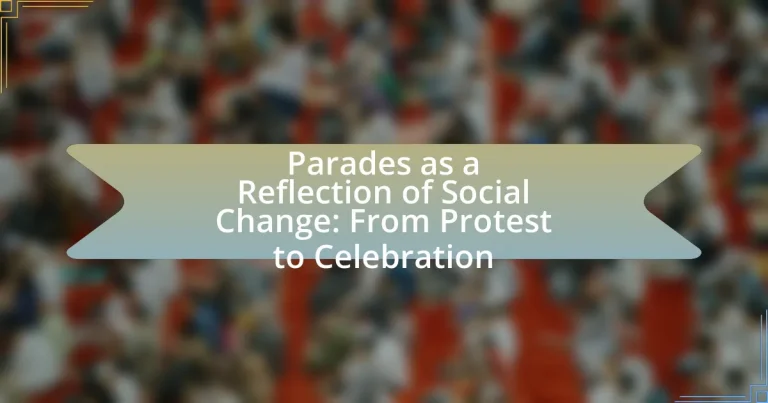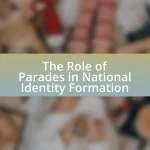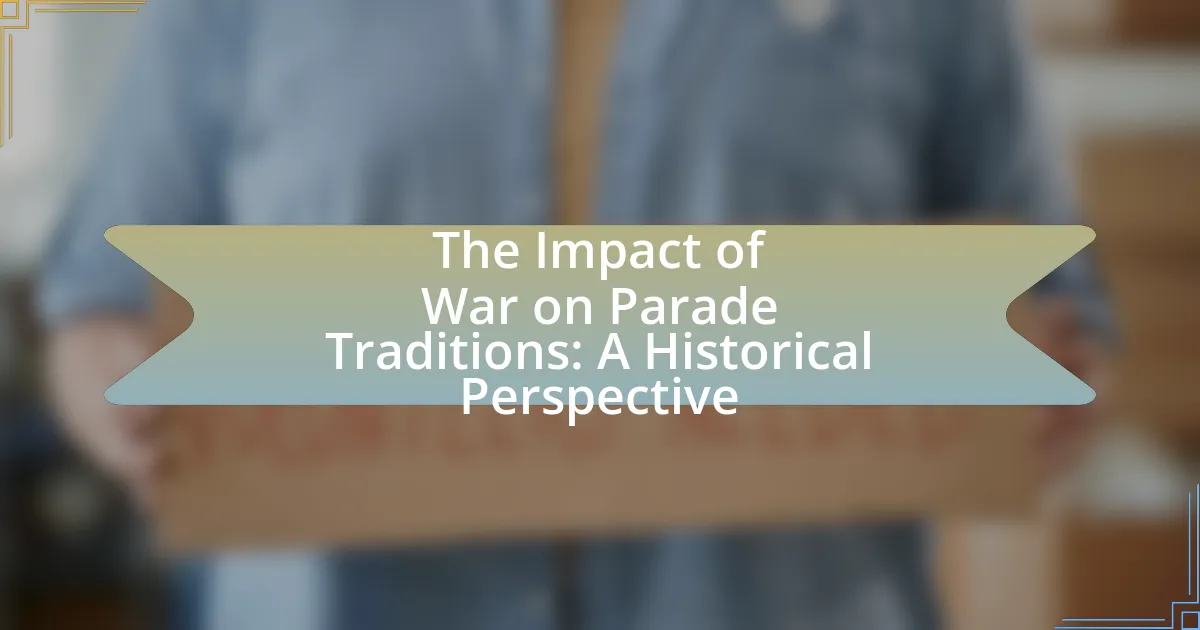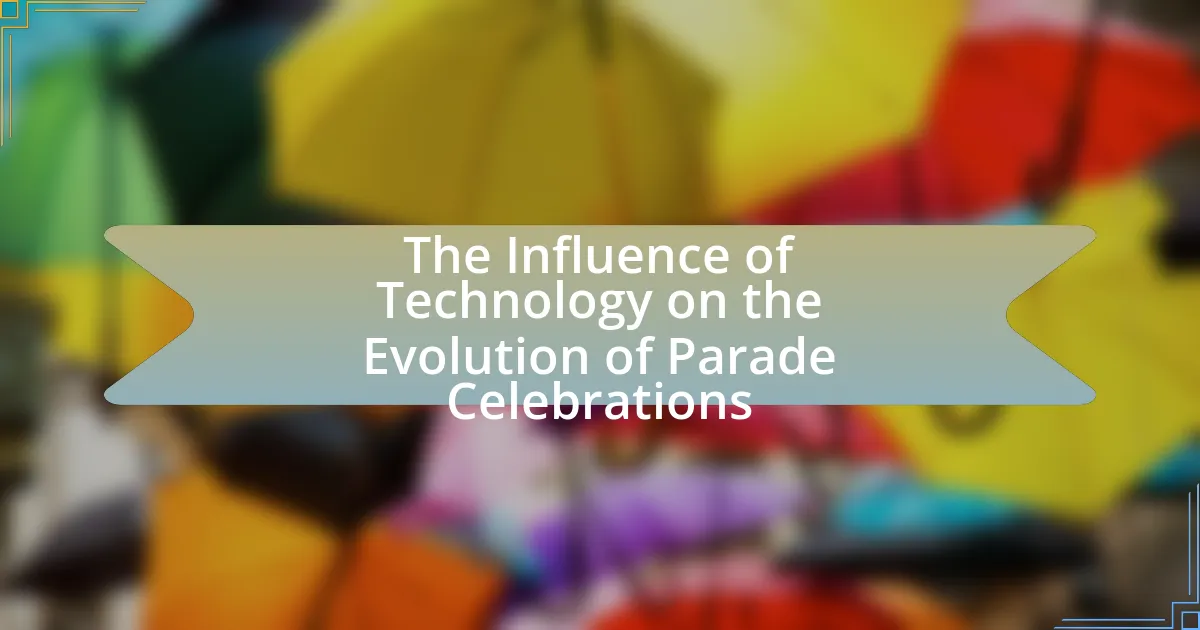Parades are organized public celebrations that serve as significant cultural events, reflecting social and political sentiments throughout history. This article explores the evolution of parades from ancient military and religious displays to modern celebrations of community and social movements, highlighting their role in advocating for civil rights and social justice. Key themes include the transformation of parades from protests to celebrations, the influence of historical events on their nature, and the various types of parades that exist globally. Additionally, the article discusses best practices for organizing inclusive and safe parades, emphasizing the importance of community engagement and representation in these public demonstrations.
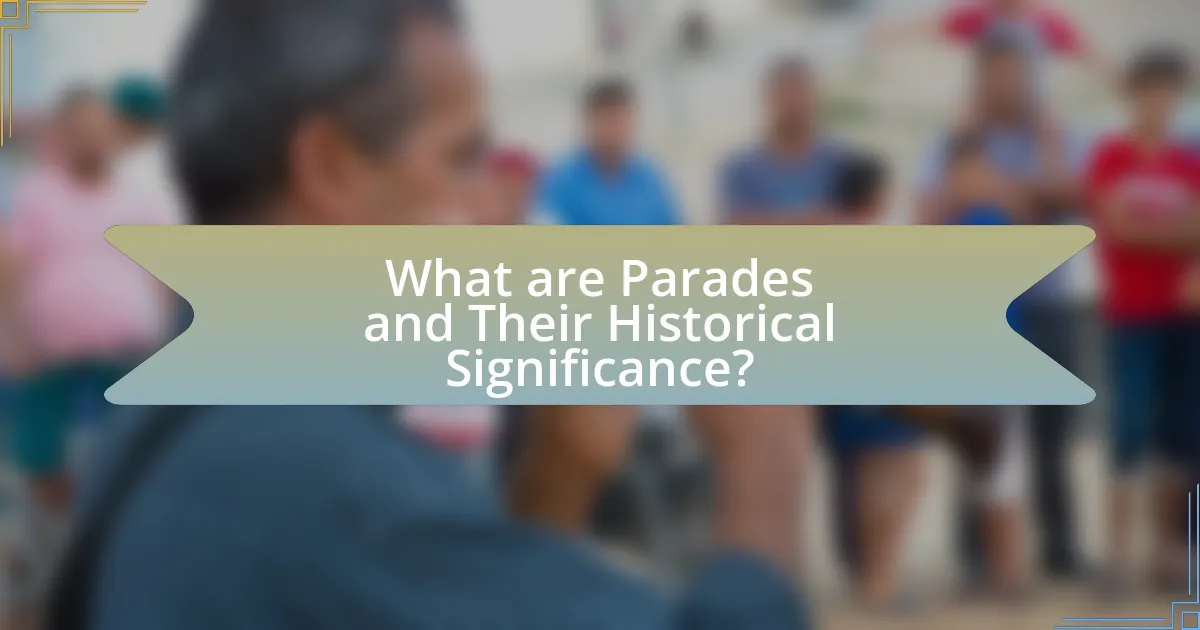
What are Parades and Their Historical Significance?
Parades are organized public celebrations that typically feature a procession of people, vehicles, and performances, often held to commemorate significant events or cultural traditions. Historically, parades have served as a means of expressing social and political sentiments, with roots tracing back to ancient civilizations where they were used to celebrate victories, honor deities, or mark important occasions. For instance, the Roman triumphs celebrated military victories, while modern parades, such as Pride parades, reflect social movements advocating for rights and recognition. This evolution highlights how parades have transitioned from displays of power and authority to platforms for social change and community celebration, illustrating their significance in shaping cultural narratives and fostering collective identity.
How have parades evolved over time?
Parades have evolved from primarily religious and military displays to multifaceted events that reflect social movements and cultural celebrations. Historically, parades served as a means to showcase power and unity, often organized by governments or religious institutions, such as the Roman triumphs or medieval processions. Over time, particularly from the 19th century onward, parades began to incorporate elements of civic pride and community identity, exemplified by events like Mardi Gras and Thanksgiving parades in the United States.
In the 20th century, parades increasingly became platforms for social change, with events like the Stonewall Riots in 1969 leading to the establishment of Pride parades, which advocate for LGBTQ+ rights. This shift illustrates how parades have transformed into expressions of social justice and community solidarity, reflecting broader societal changes. Today, parades encompass a wide range of themes, from cultural heritage to political activism, demonstrating their adaptability and significance in contemporary society.
What were the earliest forms of parades?
The earliest forms of parades were religious and military processions. These events served to honor deities, celebrate victories, or display power and unity among troops. Historical records indicate that ancient civilizations, such as the Egyptians and Romans, organized elaborate parades to showcase their achievements and reinforce social hierarchies. For example, Roman triumphs celebrated military victories with grand displays of soldiers, captives, and spoils of war, reflecting the societal values of honor and conquest.
How did historical events shape the nature of parades?
Historical events have significantly shaped the nature of parades by transforming them from expressions of military might or religious devotion into platforms for social change and celebration. For instance, the French Revolution in the late 18th century redefined parades as public demonstrations of civic pride and revolutionary ideals, moving away from royal processions. Similarly, the civil rights movement in the United States during the 1960s utilized parades, such as the March on Washington in 1963, to advocate for social justice and equality, showcasing how parades can serve as powerful tools for political expression. These historical contexts illustrate that parades evolve in response to societal shifts, reflecting the values and struggles of the times.
What role do parades play in society?
Parades serve as significant cultural events that reflect societal values, promote community cohesion, and facilitate social change. They provide a platform for collective expression, allowing individuals to celebrate shared identities, such as cultural heritage or social movements. For instance, the Stonewall Riots in 1969 led to the establishment of Pride parades, which advocate for LGBTQ+ rights and visibility, demonstrating how parades can evolve from protest to celebration. Additionally, parades often attract large audiences, fostering a sense of unity and belonging among participants and spectators, which reinforces social bonds within communities.
How do parades serve as a platform for social expression?
Parades serve as a platform for social expression by allowing individuals and communities to publicly showcase their beliefs, values, and demands. Through organized gatherings, participants can convey messages related to social justice, cultural identity, and political change, often using visual symbols, music, and performance to amplify their voices. Historical examples include the Stonewall Riots in 1969, which catalyzed the LGBTQ+ rights movement, demonstrating how parades can transform from protests into celebrations of identity and progress. Such events not only foster community solidarity but also attract media attention, further disseminating the social messages to a broader audience.
What cultural significance do parades hold in different communities?
Parades hold significant cultural importance in various communities as they serve as expressions of identity, solidarity, and social change. For instance, in LGBTQ+ communities, pride parades symbolize the fight for rights and acceptance, showcasing visibility and unity, particularly since the first pride parade in New York City in 1970, which commemorated the Stonewall riots. In many cultures, parades celebrate historical events or religious traditions, such as the Carnival in Brazil, which reflects the country’s rich cultural heritage and social dynamics. Additionally, parades can act as platforms for political protest, as seen in the Women’s March, which mobilized millions globally to advocate for gender equality and social justice. These events not only foster community cohesion but also highlight the evolving narratives within societies, illustrating how parades can transition from expressions of dissent to celebrations of progress and unity.
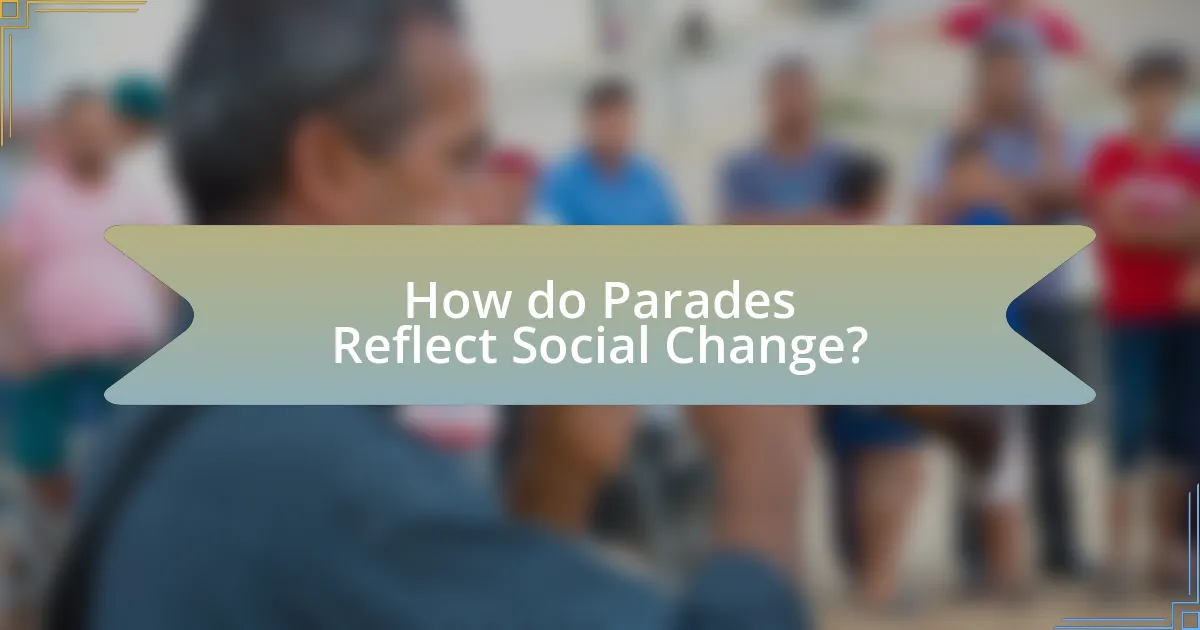
How do Parades Reflect Social Change?
Parades reflect social change by serving as public demonstrations of evolving cultural values and collective identities. They often emerge in response to significant social movements, such as the civil rights movement, where events like the 1963 March on Washington showcased demands for racial equality and justice. Additionally, parades can celebrate milestones in social progress, such as Pride parades, which highlight LGBTQ+ rights and visibility, marking shifts in societal acceptance and legal recognition. These events not only provide a platform for marginalized voices but also foster community solidarity, illustrating how public expressions can influence and mirror societal transformations.
What are the key themes of social change represented in parades?
Key themes of social change represented in parades include advocacy for civil rights, celebration of diversity, and community solidarity. Parades often serve as platforms for marginalized groups to voice their demands for equality and justice, exemplified by events like the Stonewall Riots’ anniversary, which highlight LGBTQ+ rights. Additionally, parades celebrate cultural diversity, as seen in events like the Chinese New Year Parade, which fosters understanding and appreciation of different cultures. Furthermore, parades promote community solidarity, bringing together individuals to support common causes, such as environmental awareness during Earth Day parades. These themes collectively illustrate how parades reflect and influence societal values and movements.
How do parades symbolize movements for civil rights?
Parades symbolize movements for civil rights by serving as public demonstrations of solidarity, visibility, and collective identity among marginalized groups. These events often commemorate significant historical milestones, such as the 1963 March on Washington, where over 250,000 people gathered to advocate for racial equality, highlighting the demand for justice and change. Parades create a platform for voices that have been historically silenced, fostering community engagement and raising awareness about ongoing struggles for equality. The vibrant displays of culture, unity, and purpose during these events reinforce the message of resilience and hope, making them powerful symbols of the ongoing fight for civil rights.
What role do parades play in promoting social justice?
Parades play a significant role in promoting social justice by serving as public demonstrations that raise awareness and foster community solidarity around social issues. These events often highlight marginalized voices and advocate for change, as seen in events like the Stonewall Riots’ anniversary parades, which emphasize LGBTQ+ rights and visibility. Historical evidence shows that parades have been instrumental in mobilizing support for various social movements, such as civil rights marches in the 1960s, which directly contributed to legislative changes like the Civil Rights Act. By bringing diverse groups together, parades create a platform for dialogue and collective action, reinforcing the importance of social justice in public consciousness.
How have the purposes of parades shifted from protest to celebration?
The purposes of parades have shifted from protest to celebration primarily due to changes in societal values and political climates. Historically, parades served as a platform for marginalized groups to voice dissent and demand rights, exemplified by events like the Stonewall Riots in 1969, which catalyzed LGBTQ+ pride parades. Over time, as social acceptance and legal rights for these groups improved, the focus of parades transitioned towards celebrating identity and community, as seen in the vibrant and festive nature of contemporary pride parades. This shift reflects broader social changes, where parades now often symbolize unity and joy rather than conflict and resistance.
What factors contribute to the transformation of parades into celebratory events?
The transformation of parades into celebratory events is primarily influenced by cultural shifts, community engagement, and the evolution of societal values. Cultural shifts often reflect changing attitudes towards social issues, leading to parades that initially serve as protests evolving into celebrations of progress and unity. Community engagement plays a crucial role, as increased participation from diverse groups fosters a sense of belonging and collective joy, transforming the atmosphere from one of dissent to celebration. Additionally, the evolution of societal values, such as the embrace of inclusivity and diversity, encourages parades to celebrate achievements and milestones rather than merely highlight grievances. For instance, events like Pride parades have transitioned from protests for rights to celebrations of identity and community, illustrating this transformation.
How do contemporary parades balance protest and celebration?
Contemporary parades balance protest and celebration by integrating social and political messages within festive activities. This duality is evident in events like Pride parades, where the celebration of LGBTQ+ identities coexists with advocacy for rights and recognition. Research indicates that such parades serve as platforms for marginalized voices, allowing participants to express both joy and dissent simultaneously, thereby fostering community solidarity while raising awareness about social issues. For instance, the Stonewall Riots, which catalyzed the modern LGBTQ+ rights movement, are commemorated through celebratory parades that also highlight ongoing struggles for equality.
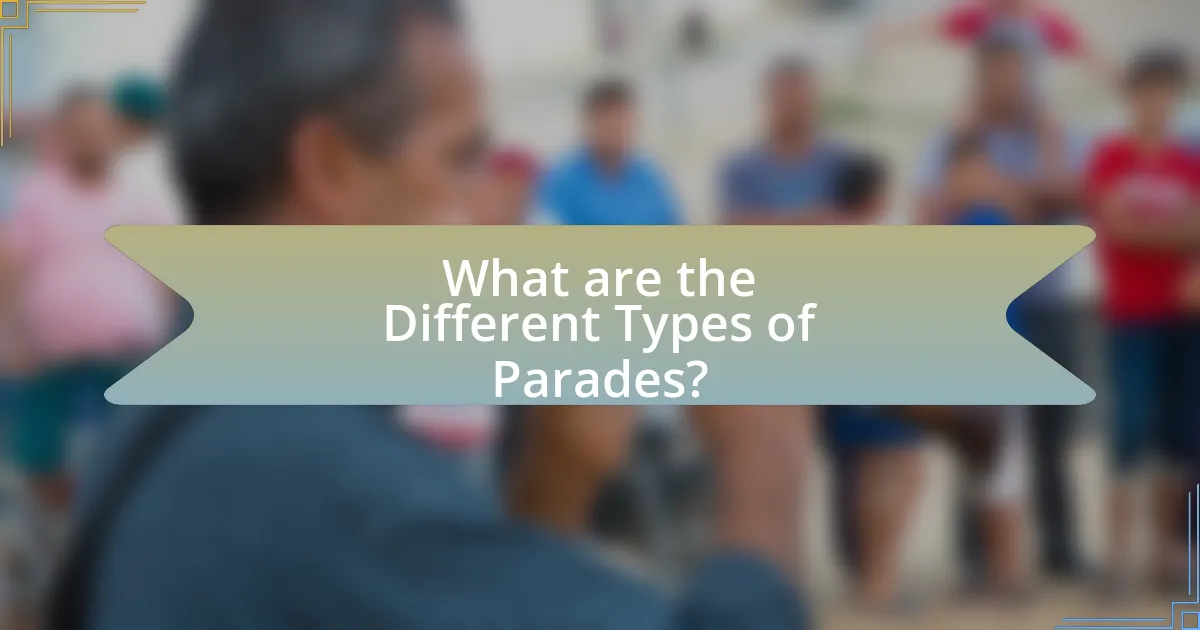
What are the Different Types of Parades?
There are several different types of parades, including celebratory parades, protest parades, cultural parades, and military parades. Celebratory parades, such as those held for national holidays or festivals, often feature floats, music, and performances to commemorate significant events. Protest parades, like those seen during civil rights movements, aim to raise awareness and advocate for social change. Cultural parades celebrate specific ethnic or cultural identities, showcasing traditions, costumes, and heritage. Military parades display armed forces and their capabilities, often held on national holidays to honor service members. Each type of parade serves a distinct purpose and reflects societal values and changes.
What distinguishes protest parades from celebratory parades?
Protest parades are distinguished from celebratory parades primarily by their intent and message. Protest parades aim to raise awareness about social issues, express dissent, or demand change, often addressing grievances such as inequality, injustice, or political oppression. For example, the Women’s March in 2017 sought to advocate for women’s rights and social justice. In contrast, celebratory parades focus on joy, community, and cultural pride, often commemorating events or achievements, such as the New Year’s Day Parade in Pasadena, which celebrates the arrival of a new year with festive floats and performances. The intent behind these parades shapes their tone, themes, and the emotions they evoke in participants and observers.
What are the common characteristics of protest parades?
Protest parades commonly feature organized groups of individuals marching to express dissent or advocate for social change. These parades typically include visual symbols such as banners, signs, and flags that convey specific messages or demands. Additionally, protest parades often involve chants or slogans that unify participants and amplify their voices. Historical examples, such as the Civil Rights March on Washington in 1963, illustrate how these characteristics serve to mobilize public support and draw attention to social issues. Furthermore, protest parades frequently occur in public spaces, aiming to engage a broader audience and influence public opinion or policy.
How do celebratory parades differ in their organization and execution?
Celebratory parades differ in their organization and execution primarily through their purpose, planning, and participant engagement. Celebratory parades, such as those for national holidays or cultural festivals, are typically organized with a focus on community involvement, entertainment, and positive messaging, often featuring floats, performances, and music. In contrast, the execution of these parades emphasizes inclusivity and joy, aiming to foster a sense of unity among participants and spectators.
For example, the Macy’s Thanksgiving Day Parade in New York City showcases elaborate floats and performances, requiring extensive logistical planning, including permits, safety measures, and coordination with local authorities. This contrasts with protest parades, which may prioritize visibility and advocacy over entertainment, often focusing on specific social issues and requiring different organizational strategies, such as securing permits for demonstrations and ensuring the safety of participants in potentially volatile environments. The differences in organization and execution reflect the underlying goals of the parades, with celebratory events aiming to uplift and engage communities while protest parades seek to raise awareness and drive social change.
How do cultural and regional differences influence parade types?
Cultural and regional differences significantly influence parade types by shaping their themes, participants, and purposes. For instance, in the United States, parades like the Macy’s Thanksgiving Day Parade reflect a blend of commercialism and celebration of national culture, while Mardi Gras parades in New Orleans emphasize local traditions, music, and community identity. Additionally, cultural festivals in different regions, such as Diwali in India or Carnival in Brazil, showcase unique customs and historical narratives, influencing the style and execution of parades. These variations highlight how local values, historical contexts, and social dynamics dictate the nature and significance of parades, making them distinct expressions of cultural identity and social change.
What unique features do parades in different countries exhibit?
Parades in different countries exhibit unique features that reflect their cultural heritage, social values, and historical contexts. For instance, Brazil’s Carnival parades are renowned for their vibrant samba music, elaborate costumes, and large floats, showcasing the country’s Afro-Brazilian culture and celebrating freedom and joy. In contrast, the Macy’s Thanksgiving Day Parade in the United States features giant character balloons and performances, emphasizing community and gratitude, while also serving as a commercial spectacle. Additionally, the Day of the Dead parades in Mexico incorporate traditional elements like calaveras (skulls) and marigolds, honoring deceased loved ones and celebrating life. These distinctive characteristics highlight how parades serve as a medium for cultural expression and social commentary, adapting to the values and histories of each nation.
How do local traditions shape the nature of parades?
Local traditions significantly shape the nature of parades by influencing their themes, rituals, and community participation. For instance, parades often incorporate cultural symbols, music, and dance that reflect the historical and social context of the community, such as the Mardi Gras celebrations in New Orleans, which blend French, African, and Spanish influences. These local traditions not only dictate the visual and auditory elements of the parade but also foster a sense of identity and belonging among participants, as seen in the annual Pride parades that celebrate LGBTQ+ rights and heritage, showcasing the evolution of social acceptance. Furthermore, the incorporation of local customs can transform parades from mere celebrations into platforms for social change, as evidenced by the use of parades in civil rights movements, where traditional elements are repurposed to convey messages of equality and justice.
What are the best practices for organizing a parade?
The best practices for organizing a parade include thorough planning, community engagement, and adherence to safety regulations. Effective planning involves setting clear objectives, determining the parade route, and securing necessary permits. Engaging the community ensures participation and support, which can be achieved through outreach efforts and collaboration with local organizations. Safety regulations must be prioritized by coordinating with law enforcement and emergency services, conducting risk assessments, and ensuring crowd control measures are in place. These practices are validated by successful parades, such as the annual Macy’s Thanksgiving Day Parade, which exemplifies meticulous planning and community involvement, resulting in a safe and enjoyable event for all participants.
How can organizers ensure inclusivity and representation in parades?
Organizers can ensure inclusivity and representation in parades by actively engaging diverse community groups in the planning process. This involvement allows for a variety of voices and perspectives to be heard, ensuring that the parade reflects the demographics and values of the community it represents. For instance, research shows that parades that include input from marginalized groups, such as LGBTQ+ communities and people of color, result in more inclusive events that celebrate a broader spectrum of identities. Additionally, organizers can implement policies that prioritize diverse participation, such as inviting representatives from various cultural organizations to lead segments of the parade. This approach not only enhances representation but also fosters a sense of belonging among participants and spectators alike.
What strategies can be employed to promote safety and enjoyment during parades?
To promote safety and enjoyment during parades, organizers should implement crowd management strategies, establish clear communication channels, and ensure adequate emergency services are present. Effective crowd management can include designated pathways for participants and spectators, which helps prevent overcrowding and potential accidents. Clear communication, such as signage and announcements, informs attendees about safety protocols and event schedules, enhancing their experience. Additionally, having emergency services on-site, including medical personnel and security, ensures that any incidents can be addressed promptly, contributing to a safer environment. These strategies have been shown to reduce incidents and improve overall satisfaction during large public gatherings, as evidenced by successful implementations in various cities during major events.
